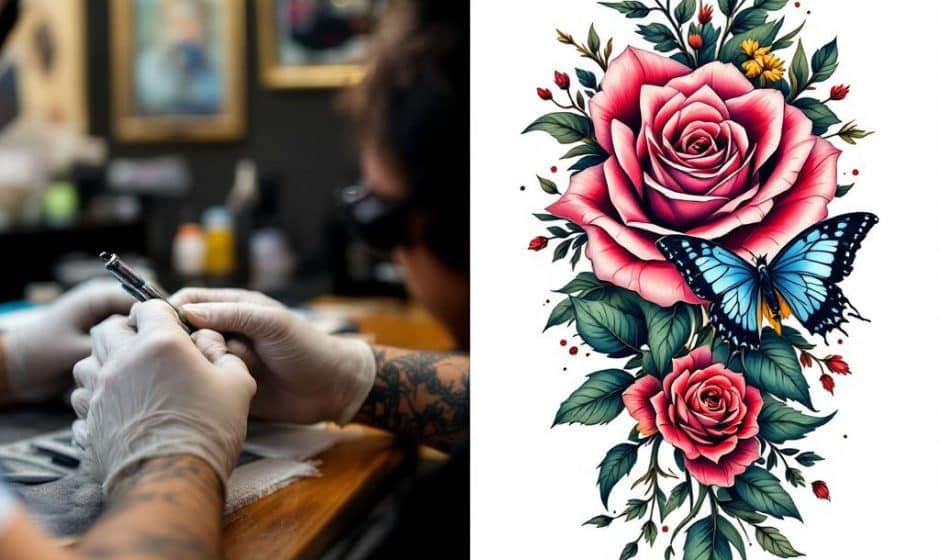Hey there! Ever wonder what it really takes to be a tattoo artist, beyond the ink and needles? Or maybe you’re curious about what goes on behind those intricate designs that we proudly display on our bodies. Rest assured, you’re not alone in thinking this. Diving into the world of tattoo artistry is like opening a portal to a rich, vibrant culture where art meets body, creativity meets precision, and passion meets patience.
Tattooing isn’t just about etching lines on skin; it’s a beautiful concoction of art, emotion, and skill. It’s a career that requires a delicate balancing act of creating while maintaining one’s health. Those pieces of art we admire on the human canvas? They’re a testament to both the tattoo artist’s talent and their dedication to perfecting the craft in a physically demanding role.
Ready to explore what it takes to become a tattoo artist? Let’s roll up our sleeves and get into the nitty-gritty of becoming and thriving as a tattoo artist, with a special nod toward maintaining a healthy lifestyle throughout.
Understanding the Craft of Tattooing
The Art and Technique
Tattooing is as much about mastery of technique as it is about artistic talent. Creating a successful tattoo means striking a balance between both. Aspiring tattoo artists must first and foremost refine their drawing skills. Drawing is the essential foundation; it’s like learning the alphabet before attempting to write poetry.
Once you’re confident in your artistry, the next step is technical training. This involves understanding the tattoo machine, from its components to how it operates. The way you handle the machine directly affects how well you’ll transfer designs onto the skin. So, if you’re serious about getting into this field, it would be wise to spend ample time practicing with this tool.
Client Relations
Being a tattoo artist is also about knowing your clients. Every tattoo has a story, and understanding your client’s vision is critical. Open and honest communication will ensure you capture their story in the design while offering your professional advice to achieve the best result. It’s all about trust—a crucial component to building a sustainable client-artist relationship.
The Importance of Health in Tattoo Artistry

It’s intriguing to know how much the body impacts artistic skill. Maintaining good health is essential for tattoo artists, whose work often involves long hours, detailed handwork, and staying mentally sharp. Here are some pointers to keep yourself fit for the job:
Hormone Regulation
Stress often comes with the territory. Whether it’s the pressure to meet client expectations or the intense focus required for detailed work, tattoo artists need to manage stress levels effectively to perform their best. This is where hormone regulation plays a vital role. When you keep your stress hormones in check, you’ll find it easier to maintain steady hands and clear thinking.
Simple strategies like practicing mindfulness, engaging in physical exercise, or ensuring adequate rest can significantly aid in hormone regulation. This naturally enhances your creativity and concentration.
Ergonomics and Physical Health
Ever consider how important posture can be? Spending multiple hours in a hunched position is tough on your body. It can lead to chronic pain if you’re not careful. Make it a habit to set up a workspace that is adjustable. This might mean investing in a comfy stool, an adjustable tattoo chair, or an ergonomic armrest. Keeping your equipment in optimal positions will save you from unnecessary strain and ensure you can deliver your best work without discomfort.
Maintaining a Sterile Environment
The health aspect isn’t just about your personal wellness, but extends to the environment you and your clients share. Ensure you work in a clean workspace. Follow the guidelines for sterilization and cleanliness meticulously. Not only does this protect you and your clients, but it also speaks volumes of your commitment to professionalism.
Steps to Becoming a Successful Tattoo Artist
So, how do you become a tattoo artist? Here’s a simple roadmap to guide you:
1. Cultivate Artistic Skills
Even before you decide on tattooing as a career, dive into art with unabashed enthusiasm. Drawing classes, sketching different styles, and experimenting with mediums will hone your skills. Over time, find your unique style. The more work you produce, the clearer it will become.
2. Research and Learn
Once you’re confident with your artistic competence, begin learning everything you can about tattooing. This includes the history, the different styles, and upcoming trends. Knowledge is power – the more you know, the better equipped you’ll be in this dynamic field.

3. Find a Mentor
Connecting with a seasoned tattoo artist can provide invaluable learning. An apprenticeship may significantly boost your understanding of practicalities, from handling equipment to customer care.
4. Gear Up
Investing in quality tools is a decision that could well make or break your journey. Much like a painter’s brush or a musician’s instrument, the quality of your tools matters. Choose your tattoo machine, needles, inks, and sanitary supplies wisely. They are your trusted partners in bringing your artistic visions to life.
5. Build a Portfolio
Your portfolio is your calling card in the tattoo world. Document your best work, highlighting the diversity of designs you’ve mastered. A well-organized portfolio helps potential clients and employers to see the range and quality of your work. Keep it updated and filled with your most inspiring pieces.
6. Engage with Community
Tattooing is about being part of a vibrant community, both locally and globally. Attend conventions, join social media groups, and participate in discussions. Interaction with others who share your passion will expose you to diverse perspectives and fresh ideas.
Balancing Creativity with Lifestyle
Never forget that the lifestyle you lead will affect your creative output. Long hours and intense concentration can demand a lot. Here’s a small reminder of maintaining a holistic approach to life, enabling sustained creativity and productivity:
Consistent Practice
Like any skill, tattoo artistry grows with constant practice. Allocate time regularly for sketching and experimentation, even outside your scheduled tattoos. This continuous practice will keep your technique on point and innovation flowing.

Emotional Well-being
A clear headspace is crucial. When your emotions weigh heavy, it reflects in your work. Energy management is almost as important as time management. Identify what replenishes your spirit—be it time with loved ones, a walk in the park, or simply some quiet reading time.
Self-Reflection and Growth
Periodically, it’s beneficial to take a step back and evaluate your progress. What are your strengths? Where might you improve? This honesty with oneself points you towards personal development. Sometimes, even the smallest course correction can propel you on the right path.
Looking Forward: Trends and Innovations
As you advance in your career, staying ahead of trends will help you innovate and remain relevant. Tattoo artistry has evolved with technology integrations offering fresh opportunities:
Digital Design Tools
Apps and styluses allow intricate design crafting with precision, paving the way for versatility and finer control over your output. Embrace these tech advancements to expand your skill set.
Nutritional Balance for Tattoo Artists
We can’t overlook the power of a balanced diet that supports hormone regulation, enhances mood stability, and keeps you energized. It’s not just veggies for vegans; it’s about finding the right balance that suits your lifestyle, whether you’re indulging in the green smoothie fad or reaching for hearty grains.
Concluding Thoughts
Being a tattoo artist involves an engaging blend of creativity and proficiency, backed by a deep respect for tradition and health—a playground for those with a passion for art on skin, seamlessly guided by the need for self-care and professional diligence.
Remember, this journey is a marathon, not a sprint. Embrace the process, the challenges, and the evolution that comes with being an artist. So, ready your tools, dive headfirst into creativity, and trust in the path you carve out with every line and shade. Trust me: in the end, you’ll have a masterpiece to show – not just on skin, but within the life you live as an artist.
Frequently Asked Questions
What causes a hormonal imbalance?
A hormonal imbalance can be caused by natural changes or stages in your life, including puberty, pregnancy, perimenopause, and menopause. Additionally, hormone levels can dramatically decrease after a partial or full hysterectomy. Other causes include tumors, adenomas, and damage or injury to endocrine glands, as well as autoimmune diseases that attack hormone-producing glands[3][5].
How does hormone replacement therapy (HRT) work?
Hormone replacement therapy works by topping up or replacing missing hormones. During perimenopause and menopause, levels of oestradiol, progesterone, and sometimes testosterone decline. HRT involves prescribing hormones to improve symptoms and future health, often including oestradiol and progesterone, and sometimes testosterone, in various forms such as patches, gels, or sprays[1][3].
What are the common symptoms of a hormonal imbalance?
Common symptoms of a hormonal imbalance include irritability and fatigue, mood swings and depression, skin dryness and loss of elasticity, water retention and weight gain, osteoporosis and joint pain, less interest in sex, insomnia and other sleep disorders, and memory issues and difficulty concentrating[3][5].
What are the different types of hormone replacement therapy?
Hormone replacement therapy comes in various forms, including systemic hormone therapy (in pill form, patches, rings, gels, creams, or sprays), low-dose vaginal products (cream, tablet, or ring forms), and bio-identical hormone replacement therapy, which is structurally identical to human hormones and may have fewer side effects[1][3].
References




